Testing, communication, personalisation – Your guide to Online Fundraising
Optimize fundraising emails and donation processes – 6 small adjustments with a big effect!
Together with our partners NextAfter and Salesforce, we donated to 630 organizations in 9 countries and signed up for the corresponding newsletters – 80 of which are German organizations. How did the organizations react to donating or subscribing to the newsletter? What are the differences in communication between newsletter subscribers and first-time donors? Find out what we learned and how you can use these insights to optimize your online fundraising in this blog article. Let’s go!
*Unless otherwise noted, this article refers to the results of the Global Online Fundraising Scorecard, which you can access here.
1. Avoid digital fundraising pitfalls – identify sources of error!
Did you know that in Germany 1 out of 10 online donations are not completed? Most often, this is because a form, link or integration does not work properly, resulting in a canceled donation. Fortunately, this can be prevented with little effort: By donating a few euros to their own organization, fundraisers can test their set-up and experience the donation process from the donor’s point of view. By doing so, sources of error can quickly be identified and remedied.
The same applies for newsletter signups: in Germany, approximately 24% of newsletter signups cannot be completed. Our advice here is very simple: test your processes, test your integrations and then test them again. You will develop a much smoother process and keep those donations and newsletter subscriptions coming in.
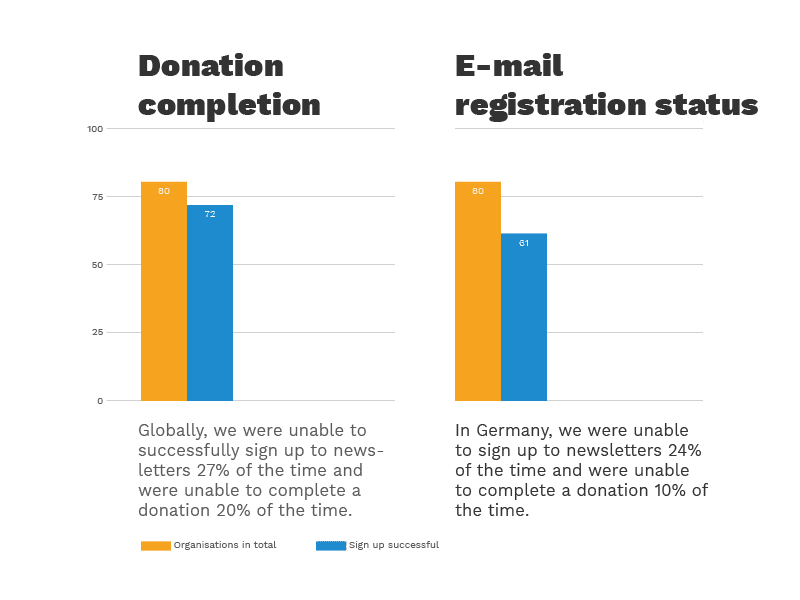
Source: www.nextafter.com
2. A shut mouth catches no donors – always communicate the benefits of your newsletter
On an international average, 75% of organizations do not provide a good reason to sign up to a newsletter. In Germany, things look a whole lot more bleak : A mere 5% of organizations provide a compelling reason to subscribe. What does a compelling reason sound like? Ideally, the sign-up form contains a clear but concise text highlighting the valuable information your newsletter offers while emphasizing the scarcity of this information*.
This presents a huge opportunity for German organizations! Because on average, they provide the reason for newsletter registration in just 0.7 sentences. Need even more facts and figures? An appropriately placed text that highlights the value of the newsletter has a decisive impact on sign-ups: up to 276%, to be exact (source: Nextafter) (More about A/B testing). When you fine-tune your newsletter sign-up form like this, one thing becomes very clear to potential newsletter subscribers: that you offer valuable content which they can only get from you. In other words: the benefits of your newsletter are your subscriber magnet!
*The factors mentioned here are from the Value Proposition: Net Force by Meclabs.com.
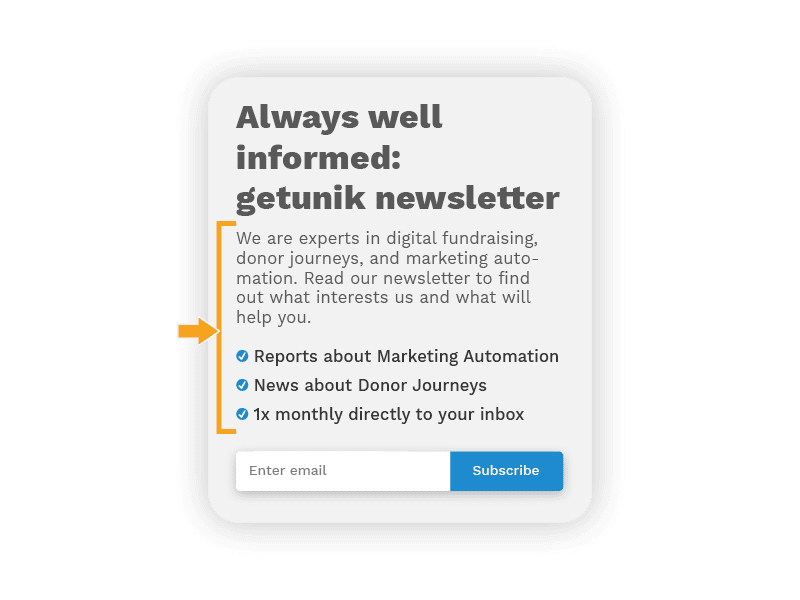
Source: www.nextafter.com
3. successful fundraising needs great landing pages!
What happens on your website when a new contact signs up to your newsletter? The sign up form displays a brief thank you message but little else? Then keep on reading! A dedicated landing page for new newsletter subscribers can work miracles. It is another opportunity to provide useful information to interested users. Need some inspiration? Your landing page could cover the following topics:
- Acknowledgement
- Additional things to note (e.g. confirm opt-in mail)
- Tips to avoid spam
- A donation ask
Yes, even a donation ask has its place on such a page. As we know from behavioural psychology’s “foot-in-the-door principle” asking for a donation at this point in time can be quite effective. If users agree to a small request (newsletter subscription), it is more likely that they will also agree to the next, larger request (donation). The likelihood that new subscribers will convert directly to donors is also significantly determined by the type of content that subscribers receive. An eBook, for example, generally achieves a much higher conversion rate than a petition (source: Nextafter).
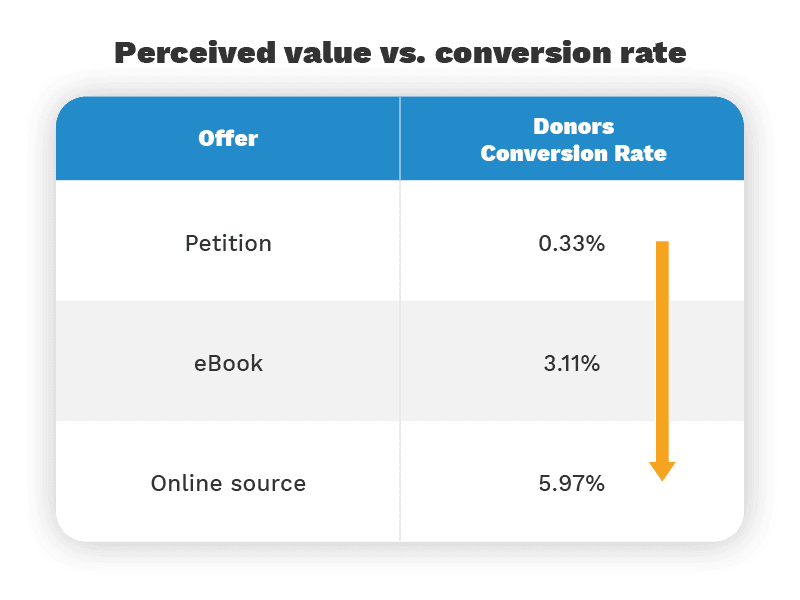
Source: www.nextafter.com
4. Communicate the advantages of a regular donation!
One-time donations are great, but recurring donations are even better! In Germany, 90% of all organizations offer the option of recurring donations. However,97% of these organizations do not provide a compelling reason in their donation form to opt for recurring donations. This is a shame because communicating the impact of a recurring donation has proven to motivate visitors to donate on a monthly basis. To encourage recurring gifts, a “Did you know?” infobox with two short sentences highlighting the advantage of a monthly donation compared to a one-time donation can already be enough to convince a potential donor (48% more monthly donations) (Source: Nextafter).
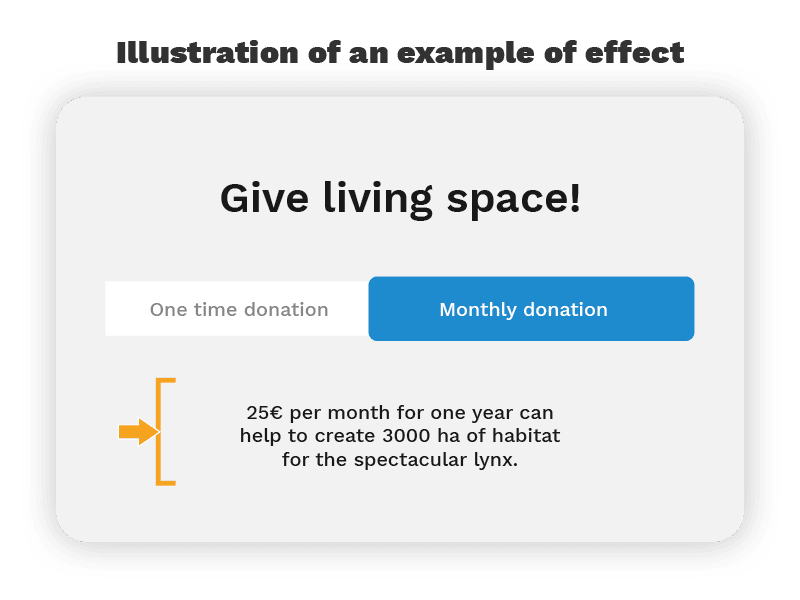
Source: www.nextafter.com
5. Send more fundraising emails!
In Germany, there is still room for improvement in terms of fundraising email communication. On average, donors receive only 1.2 emails in the first 14 days following a donation – and a large proportion of these are only confirmation emails. This puts Germany in last place compared to the countries surveyed by Nextafter, Salesforce and us.
Our advice: see this as a great opportunity to win over new donors. How so? With, for example, an automated welcome journey that welcomes all new donors (and newsletter subscribers) and cultivates a relationship to them. Such a journey does not have to be very complex. A confirmation email, a thank you email, some information about your organization, a link to a blog article or a success story – and your first welcome journey is complete. The best thing about it? You can even build up to a second fundraising appeal during the course of such a journey and increase the impact each newly acquired donor can have!
You can find more info here.
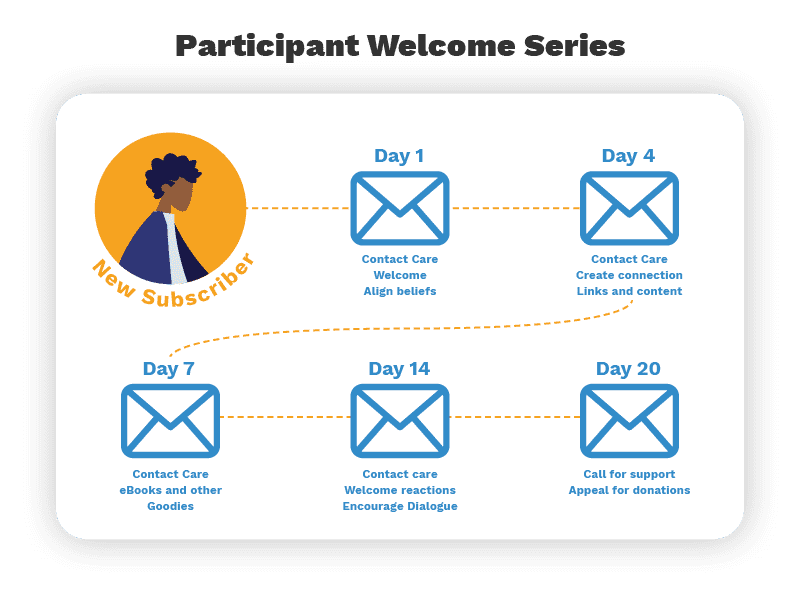
Source: www.nextafter.com
6. Personalize donation emails!
People donate to people, not marketing automation tools. Have you ever caught yourself sending a fundraising email to thousands of contacts without thinking for even a second about the people on the other side of the screen? It pays to keep the recipient in mind when writing your emails. The more personal an email is, the more likely it is to be opened.For example, by including the recipient’s name in the subject line (22% more opens) (source: Nextafter) or by addressing them personally à la “Hello %FirstName%” (270% more clicks) (source: Nextafter). How do you enable this personalization? By requesting the name during newsletter registration!
Furthermore, by connecting your customer relationship management system (CRM) to your marketing automation tool, you can further personalize fundraising emails by drawing on the recipient’s past donation behavior and stated interests. More information on CRM integration can be found here.
The name of the sender is also often overlooked. An email sent by a person is 38% more likely to be opened than one that names an organization as its sender (source: Nextafter). In addition, it makes a difference which person sends the email. An email from a CEO is opened less often than one from a speaker (+85% opens and +150% donations) (Source: Nextafter).
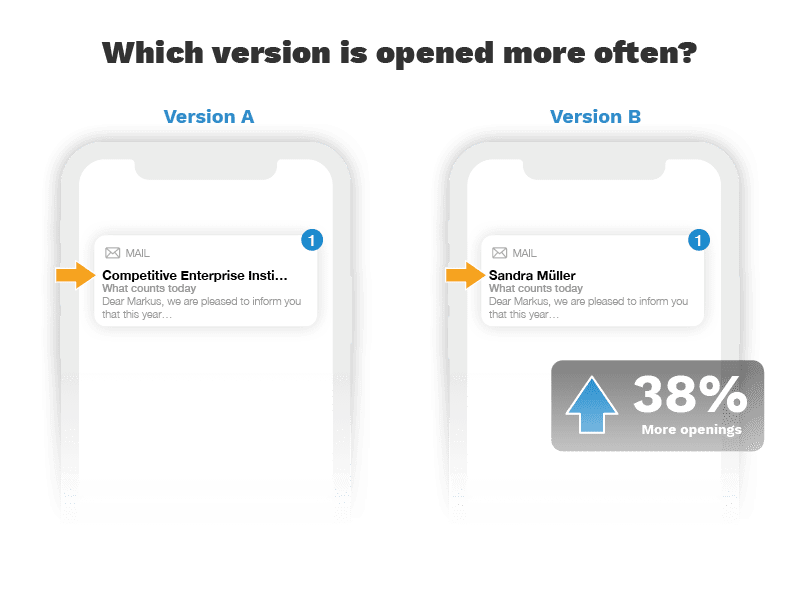
Source: www.nextafter.com
Want more fundraising facts?
The results above are just the tip of the iceberg. Do you want to go into more depth? Then more optimization opportunities and the corresponding figures from NextAfter’s Global Online Fundraising Scorecard are waiting for you here. Be sure to take a look.
You want to get started with optimizing your online fundraising and generate more online donations? Then don’t hesitate – get in touch with us!
